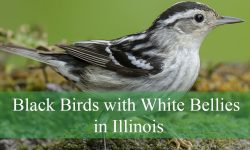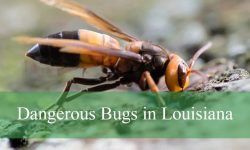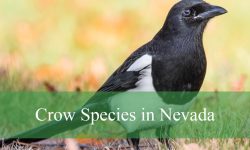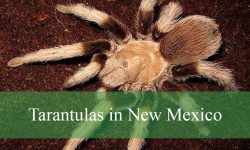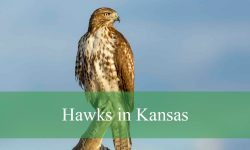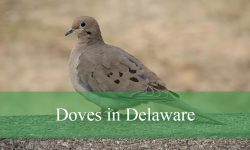Feral pigs have become one of the most concerning invasive animals in North America, known for their intelligence, adaptability, and destructive feeding habits. Although Washington State does not currently have large, established populations of wild pigs like some southern states, there have been confirmed sightings and occasional reports of feral swine roaming rural and agricultural areas.
In Washington, there are two main genetic types of feral pigs: the Feral Domestic Pig and the European Wild Boar Hybrid. Both belong to the same species, Sus scrofa, but they differ in origin, physical characteristics, and behavior. Understanding these two types is important for recognizing and reporting sightings to prevent ecological damage.
This guide will help you identify the two types of feral pigs in Washington, learn how they differ, and understand their impact on the local environment.
What Are Feral Pigs?
Feral pigs (Sus scrofa) are wild-living descendants of domestic pigs that have escaped captivity or been intentionally released. Once free, these animals quickly adapt to life in the wild, developing survival behaviors and physical traits similar to true wild boars.
Feral pigs are opportunistic omnivores that feed on a wide range of foods—roots, crops, insects, small mammals, and even carrion. Their rooting behavior, while essential for finding food, destroys native vegetation, agricultural land, and wildlife habitats.
They are also vectors for several diseases, including brucellosis, pseudorabies, and leptospirosis, which threaten livestock and potentially humans. For these reasons, feral pigs are listed as deleterious exotic wildlife in Washington State, making it illegal to release or transport them.
Are Feral Pigs Common in Washington?
Compared to states like Texas, Florida, or California, Washington has relatively few feral pig populations. The Washington Invasive Species Council and the USDA’s Wildlife Services have confirmed occasional sightings, primarily in southwestern counties such as Lewis, Cowlitz, and Skamania.
Most of these animals are thought to originate from escaped domestic pigs or small populations introduced by hunters. Fortunately, Washington’s cooler climate and proactive monitoring programs—like the “Squeal on Pigs!” campaign—have prevented major infestations so far.
Still, the potential for establishment remains high, as feral pigs reproduce quickly and can adapt to diverse habitats, from dense forests to farmland.
2 Types of Feral Pigs in Washington
There are two primary types of feral pigs found or potentially found in Washington:
- Feral Domestic Pig (Sus scrofa domesticus – escaped or released farm pigs)
- European Wild Boar Hybrid (Sus scrofa scrofa – imported or mixed ancestry)
Let’s look at each type in detail, including their identification features, behavior, and habitat preferences.
1. Feral Domestic Pig

Characteristics and Identification
The feral domestic pig is the most common type found in Washington. These pigs descend from domesticated farm pigs that either escaped or were abandoned and adapted to wild conditions. Over time, they develop tougher coats, leaner bodies, and more cautious behavior than their farm-raised ancestors.
Their appearance varies widely depending on breed origin. Colors include black, gray, brown, red, or spotted combinations. They usually have coarse bristles, straight tails, and elongated snouts. Adult males grow visible tusks that curve outward and upward, though they are typically smaller than those of true wild boars.
Feral domestic pigs can weigh between 150 to 300 pounds, with boars occasionally exceeding 400 pounds. Their bodies are less streamlined than wild boars, and their legs are shorter, giving them a heavier, lower-to-the-ground profile.
Behavior and Habitat
Feral domestic pigs are intelligent, social, and highly adaptable. They form small groups known as sounders, typically consisting of females and their offspring. Adult males are more solitary and only join groups during the breeding season.
In Washington, these pigs prefer wooded areas near farms or rivers, where food and water are abundant. They spend much of their time rooting in soil for bulbs, insects, and roots. This rooting behavior destroys native plants and disrupts soil structure, leading to erosion and habitat loss for ground-nesting birds and amphibians.
Feral pigs are also excellent swimmers and can travel across rivers or lakes, which helps them spread into new areas.
Reproduction and Growth
One of the main reasons feral pigs are so invasive is their incredible reproductive rate. A single sow can produce 2 litters per year, with 4–10 piglets per litter. Piglets mature quickly and can reproduce within 6 to 10 months.
In Washington’s climate, reproduction tends to peak during spring and early summer, when food is plentiful. Even small populations can grow rapidly if not managed, making early detection essential.
Impact on Washington’s Environment
Feral domestic pigs cause significant ecological and agricultural damage. They uproot crops, destroy native plants, and consume ground-nesting bird eggs. Their wallowing behavior also muddies streams, degrading water quality and increasing sedimentation.
They compete with deer and elk for acorns and other forest foods and may even prey on small mammals, reptiles, and amphibians. Farmers in southwestern Washington have reported property damage and losses due to feral pig activity.
2. European Wild Boar Hybrid
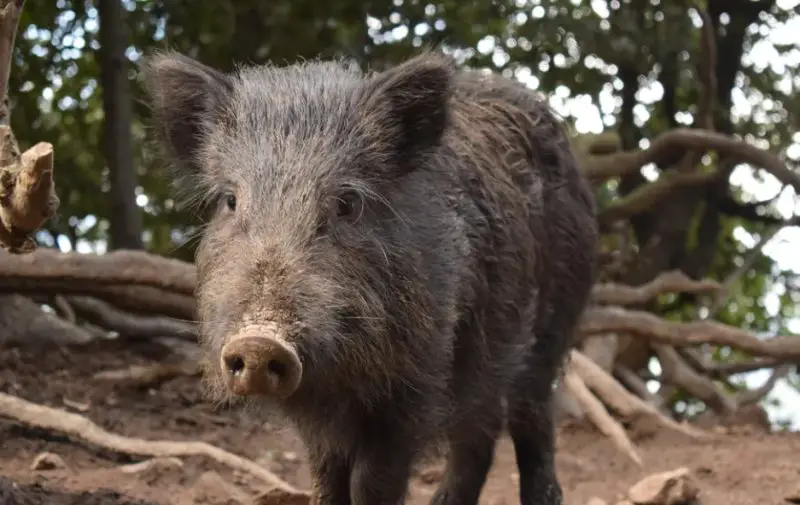
Characteristics and Identification
The European Wild Boar Hybrid represents animals with partial ancestry from European wild boars. These hybrids may have been imported for game hunting decades ago or interbred with feral domestic pigs. While rare in Washington, they pose a serious threat if populations become established.
These pigs are more muscular, with longer legs, dense dark bristles, and a distinct mane of coarse hair running down the back. Their coloration is usually dark brown to black, and their tails are straight with a tufted end.
Adult males can weigh 200 to 400 pounds, though their frame is leaner and more athletic than feral domestic pigs. Their tusks are longer and sharper, and their snouts are narrower—built for rooting deep into the soil for roots and tubers.
Behavior and Habitat
Wild boar hybrids are more wary and aggressive than feral domestic pigs. They are primarily nocturnal and avoid human activity, making them harder to detect. These pigs are highly intelligent and have keen senses of smell and hearing, allowing them to evade traps or hunting efforts.
In Washington, they prefer dense forests and rugged terrain, particularly in areas with oak trees, where acorns provide a rich food source. They also thrive near agricultural land, where they can forage on grains, vegetables, and fruits.
Wild boar hybrids are known for digging and wallowing, creating muddy pits near water sources. These wallows are used to regulate body temperature and remove parasites.
Reproduction and Growth
European Wild Boar Hybrids share similar breeding patterns with feral domestic pigs, though they may breed slightly less frequently in colder climates. Females can produce 4–8 piglets per litter, and young grow rapidly.
Because these pigs are more cautious, they are less frequently seen, but once a breeding population takes hold, it can be extremely difficult to eliminate. They adapt quickly to hunting pressure by becoming more nocturnal and expanding their home ranges.
Impact on Washington’s Ecosystem
Even small numbers of wild boar hybrids can devastate ecosystems. Their rooting behavior damages forest floors, increases soil erosion, and uproots tree seedlings. They also feed on native invertebrates, reptiles, and bird eggs, reducing biodiversity.
In agricultural zones, they destroy crops, tear up irrigation systems, and spread diseases to livestock. Their presence threatens both economic and environmental health in rural Washington.
Comparison Between the Two Types
Feature |
Feral Domestic Pig |
European Wild Boar Hybrid |
|---|---|---|
Origin |
Escaped farm pigs |
Imported or hybrid wild boars |
Body Type |
Stockier, shorter legs |
Lean, muscular, longer legs |
Color |
Variable (black, brown, spotted) |
Dark brown or black |
Tusks |
Short to medium |
Long, sharp, curved |
Temperament |
Generally less aggressive |
More aggressive and wary |
Habitat in WA |
Farms, river valleys, mixed forests |
Dense forests, mountain regions |
Population Status |
Occasional sightings |
Extremely rare or absent |
Threat Level |
High |
Very high if established |
How to Identify Feral Pigs in the Wild
Spotting feral pigs can be tricky, especially since they often move at night. Here are a few clues to help identify their presence:
1. Rooting Damage
Look for patches of upturned soil, sometimes several feet wide, resembling the aftermath of a rototiller. This is a clear sign of pig foraging.
2. Wallow Pits
Muddy depressions near ponds or creeks indicate pigs have been rolling in the mud to cool off or remove parasites.
3. Tracks and Droppings
Pig tracks show rounded hooves with two main toes. Their droppings are cylindrical and often contain seeds, roots, or insect parts.
4. Sightings or Sounds
Feral pigs make grunting and squealing sounds, especially when traveling in groups. They often move during dawn or dusk hours.
If you suspect feral pig activity, report it immediately to the Washington Department of Fish and Wildlife (WDFW) or through the “Squeal on Pigs” website to help prevent spread.
Ecological and Economic Impact in Washington
Even though large populations have not yet formed, feral pigs are considered one of the most destructive invasive species in North America. Their impact in Washington could be devastating if not controlled.
Environmental Damage
- Soil disturbance: Rooting loosens soil, leading to erosion and degraded water quality.
- Habitat destruction: They destroy understory vegetation and reduce biodiversity.
- Competition with wildlife: They outcompete deer, elk, and bears for acorns and other foods.
Agricultural Losses
- Crop damage: Feral pigs can devastate corn, wheat, hay, and fruit crops overnight.
- Livestock threats: They can transmit diseases such as swine brucellosis and pseudorabies.
- Infrastructure damage: Their rooting destroys fences, irrigation systems, and water lines.
Government and Community Response
The Washington Invasive Species Council and USDA Wildlife Services work together to monitor and manage feral pig sightings. Washington has one of the most active public awareness campaigns—“Squeal on Pigs!”—which encourages citizens to report any signs of wild pig activity.
Because eradication is far easier than long-term control, early detection plays a crucial role. The state prohibits possession, transportation, or release of any feral swine to prevent new populations from forming.
How to Help Prevent Feral Pig Spread
1. Report Sightings
Use the Squeal on Pigs hotline or online form on the Washington Invasive Species Council website.
2. Never Release Pigs into the Wild
Abandoning farm pigs or transporting wild boars is illegal and contributes to invasive spread.
3. Secure Farms and Fences
Ensure livestock fencing is sturdy to prevent escapes. Regularly check for rooting damage.
4. Avoid Feeding Wild Pigs
Feeding feral pigs encourages their presence and reproduction. Report anyone intentionally feeding them.
Are Feral Pigs Dangerous to Humans?
Yes. Feral pigs can be dangerous if cornered or threatened. Adult boars possess sharp tusks capable of inflicting serious injuries. They are most aggressive during the breeding season or when protecting piglets.
In addition to physical danger, they carry diseases transmissible to humans and pets, such as leptospirosis, toxoplasmosis, and trichinosis. Avoid handling or approaching feral pigs in the wild.
FAQs About Feral Pigs in Washington
Are feral pigs legal to hunt in Washington?
No. Because they are classified as deleterious exotic wildlife, hunting or possession of feral pigs is regulated. Contact WDFW for current policies before any action.
Where are feral pigs most often seen in Washington?
Sightings have occurred in Lewis, Cowlitz, Clark, and Skamania Counties, primarily on private farmland or forest edges.
Do feral pigs survive the winter in Washington?
They can, though harsh winters limit population growth. Pigs seek shelter in dense vegetation and feed on roots, crops, and acorns during cold months.
What should I do if I see a feral pig?
Do not approach. Take photos from a distance and report immediately to state authorities. Avoid disturbing or feeding them.
Can feral pigs crossbreed with domestic pigs?
Yes. If domestic pigs escape and interbreed with wild pigs, hybrids can form, often producing more resilient offspring.
Final Thoughts
While feral pigs are not yet widespread in Washington, their potential threat is significant. Both types—the Feral Domestic Pig and the European Wild Boar Hybrid—share destructive behaviors that can harm ecosystems, farmland, and native wildlife.
Recognizing and reporting feral pig activity is critical to preventing the establishment of permanent populations. By staying vigilant and supporting state monitoring efforts, Washington residents can help keep the landscape free of this invasive and highly adaptable species.

